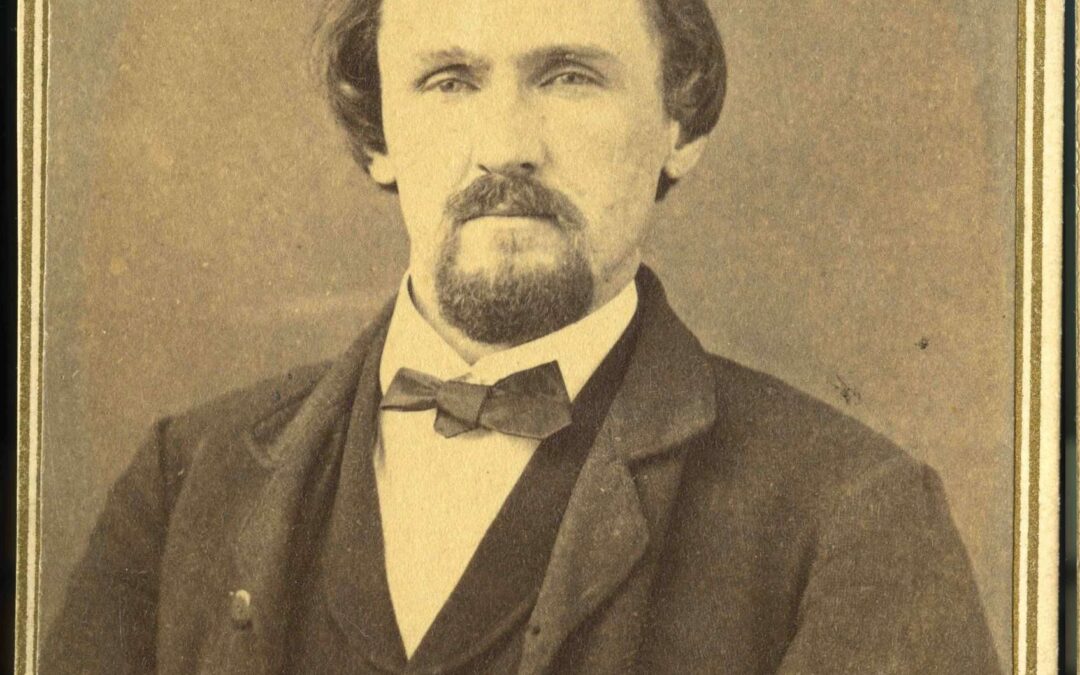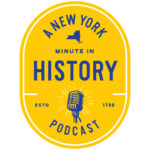
On this month’s episode, Devin and Lauren uncover a system of Confederate spies, guerillas, and terrorists attempting to wreak havoc on Western New York during the final years of the American Civil War.
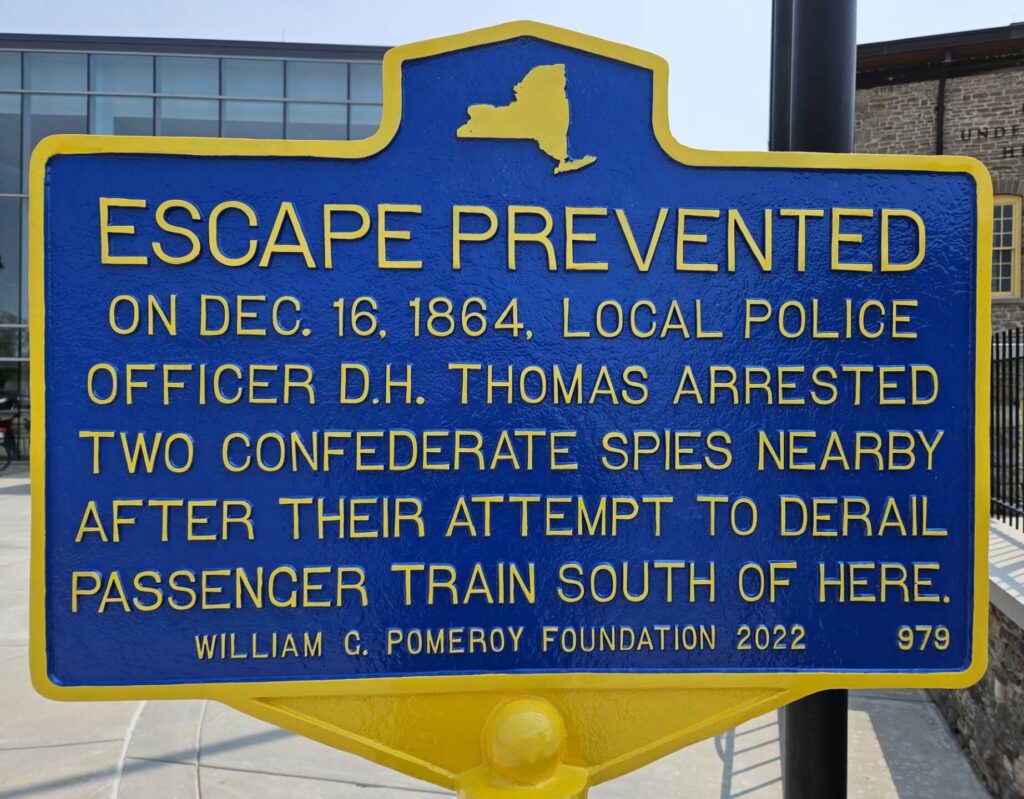
Marker of Focus: Escape Prevented, Niagara County
Guests: Anton Schwarzmueller (Project Coordinator) and Jim Ball (Board President) of the Niagara Frontier Chapter-National Railway Historical Society, Lindsey Lauren Visser, Buffalo City Historian
A New York Minute in History is a production of WAMC Northeast Public Radio and the New York State Museum, with support from the William G. Pomeroy Foundation. This episode was produced by Elizabeth Urbanczyk. Our theme is “Begrudge” by Darby.
Featured Image: John Y. Beall, credit: Library of Congress
Further Reading:
Transcript of the Trial of John Y. Beall, Library of Congress
An Irrepressible Conflict: The Empire State in the Civil War by Aaron Noble, Jennifer Lemak, and Robert Weible.
Teaching Resources:
Consider the Source New York Civil War Resources—New York State Archives Partnership
Trust
An Irrepressible Conflict Online Exhibit—New York State Museum
New York State Military Museum Civil War Resources
New York State Archives Military Records
Continuing Teacher and Leader Education (CTLE) Credit: The New York State Museum is an approved provider of Continuing Teacher and Leader Education (CTLE). Educators can earn CTLE credit (.5 hours) by listening to this episode and completing this survey Please allow up to two weeks to receive confirmation of completion.
Follow Along
Devin: Welcome to A New York Minute in History. I’m Devin Lander, the New York State historian.
Lauren: And I’m Lauren Roberts, the historian for Saratoga County. On this episode, we’re taking you to a marker located at the Amtrak train station at 825 Depot Ave West in the city of Niagara Falls, out in Niagara County. The title of the marker is “Escape Prevented” and the text reads: On December 16 1864, local police officer D.H. Thomas arrested two Confederate spies nearby after their attempt to derail a passenger train south of here. William G. Pomeroy Foundation, 2022.
So we’ve got Confederate spies attempting to derail a passenger train south of Niagara Falls, it sounds like a pretty interesting story, and one that I had never heard of in context of the Civil War. So let’s start by refreshing our memories about what was going on in the country in the 1860s.
The Civil War begins in 1861, when Confederate forces fire on Fort Sumter and we are launched into a long war – North versus South. The North certainly has the upper hand with personnel and money and infrastructure. And it becomes obvious that by 1863, the vast majority of fighting is in the south. And it begins to take a toll; they’re running out of people, they’re running out of money, they’re really getting desperate. And so that’s where we’re at here in late 1864 when our story begins, way up north on the New York Canadian border up in the Buffalo area. So what would the city of Buffalo have been like at this time during the Civil War?
Devin: Did you get all the snow?
Lindsey Lauren Visser: I did, yes! It’s… what a time to be in Buffalo. Let me tell you, you caught me right in between blizzards, it’s great.
Devin: We spoke with Buffalo city Historian Lindsey Lauren Visser to get a sense of what Buffalo was like in 1864.
Lindsey: So my name is Lindsay Lauren Visser, and I am the City of Buffalo Historian and very, very new to the position. And so at the moment just trying to raise general awareness of the depth of history for our city because it has so much to be excited about.
I think the thing that I always try to remind people is: when we think of cities within New York State, we think they’re very old, and Buffalo relative to the rest of downstate is quite young. And especially when we talk about during the Civil War period, Buffalo had only really been open to European settlement from just after the turn of the 19th century. It’s then promptly burned to the ground by the British during the War of 1812. So we’re off to a great start! So 1813, 1814, the city is rebuilding, and it’s shortly thereafter that the Erie Canal is announced and Buffalo is identified as the terminus. The Erie Canal opened in 1825 [and] completely changed the landscape for Western New York. You now have Buffalo serving as a shipment center for all of the Great Lakes, all of the Midwest, and now connecting them to the northeast. It really puts Buffalo on the map, and it puts it very quickly. But we see the railroads coming as early as 1837. So it’s literally just that tiny little nudge that Buffalo needed to really secure itself as that center. And that continues throughout the development of the rest of the 19th century, because the railroads now have to connect to Buffalo because it’s so important because the Erie Canal made it important.
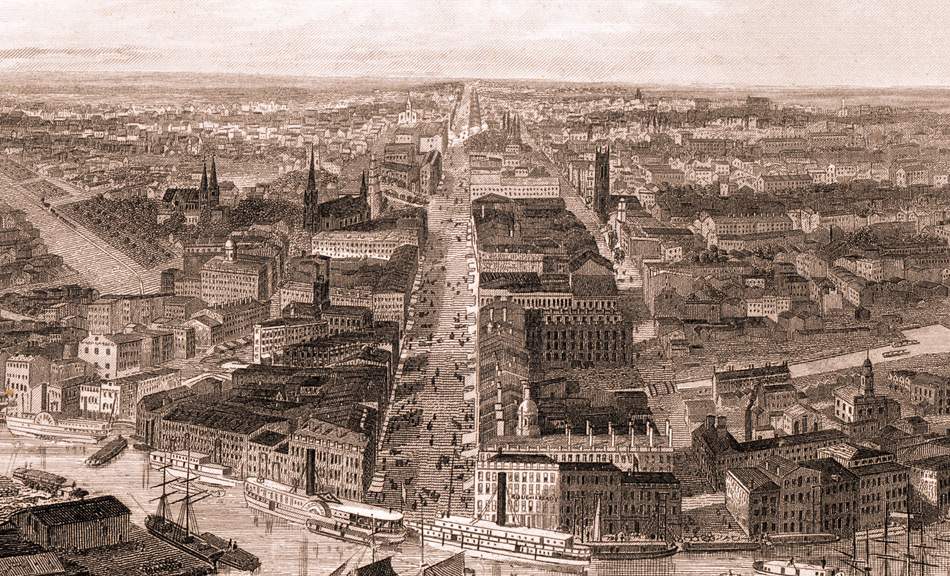
Buffalo really starts to turn the corner from just an industrial powerhouse; we start to get some amenities. This is the time period in the 1860s, where the Historical Society is formed, the Fine Arts Society is formed. So you’re starting to kind of elevate the city. And even during the Civil War, we have a number of people who are fairly instrumental in the government at that point in time, which again, I think, adds to the gravitas and the prominence of the city in general.
Devin: You don’t necessarily think of Buffalo and Niagara Falls as a battleground in the Civil War, right? We know that the vast majority of the action took place in the South, there was some in the West, there was a battle of Gettysburg, which was the one attempt that the South made to attack the North on their soil. But New York as a destination for these types of activities does make some kind of sense, right? New York was the industrial heartland of the North and the effort of the Northern cause. I mean, we know today that New York State supplied more men, more material and more money for the northern cause than any other state. So if the South was thinking about bringing the war home, and bringing it to a civilian population, that New York State could have been focused. Now, why it wasn’t New York City and why we’re talking about Buffalo is because of how close it was to the Canadian border. So in 1864, it was still part of the British Commonwealth – it was called British Canada – it was a neutral country, and therefore Southern soldiers, and people could travel there could live there, they weren’t in any way stopped at the border or anything. So they could launch clandestine activities against Buffalo and Niagara Falls from Canada.
Lauren: So it’s interesting that you say that British Canada was neutral, because this is where some of the guerrilla operatives are planning their attacks on American soil. Although they maintain neutrality, this does lead to an opportunity for Confederate spies to have some gray area where they can plot.
Lindsey: This was definitely something that the Confederacy was plotting and planning and really supporting. And so what we see is that in 1864, there’s an actual effort, if you will, to make a Clandestine Service, located out of Canada, because there was the effort to strike fear into the heart of the Union, start to disrupt things, start to really target the strategic locations. And so there’s actually a former congressman Jacob Thompson, who ends up being the head of this program, if you will, in setting up a base in Canada. And they gave him a lot of money to do this. I think it’s a draft note of a million dollars. And it’s coming at a time period in which the Confederacy does not necessarily have a ton of resources to be throwing around, so the fact that this was given that much support really does show that this was something that I think the Confederate government really was backing.
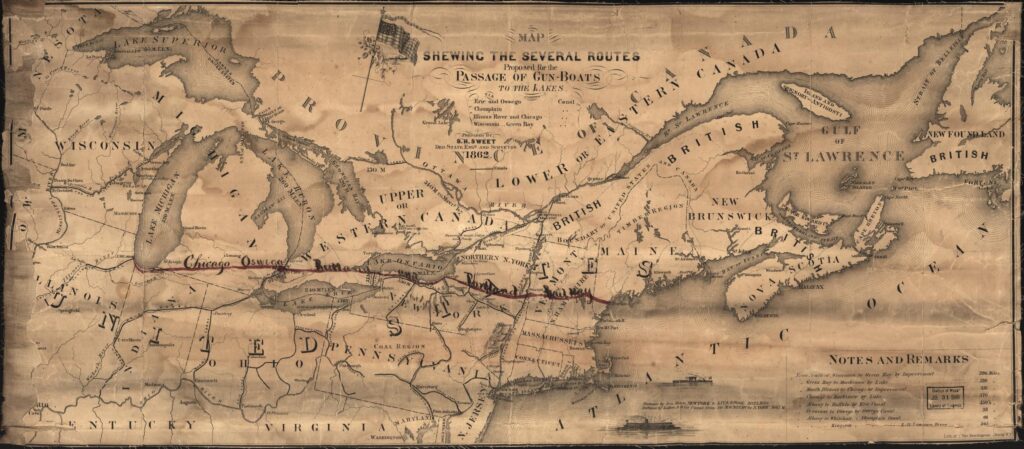
So there’s a few plots that they ended up trying to orchestrate. It’s kind of logical, but the only way I can describe it is the people who they got to do this were a bit bumbling and couldn’t really get the job done, which I suppose is good in the annals of history, if you will, that they weren’t quite as successful in what they wanted, but at the time it made for some interesting situations. I think you kind of mentioned that the attack on the USS Michigan, this was a very concerted effort to strategically do something. This one had two kind of folds to it, if you will. The first was that they were going to try to take over the Michigan because it was a prisoner transport. So you’ve got 2700 Confederate soldiers who are prisoners of war, who you’d be liberating. On top of it, the USS Michigan is a gunboat. So now you have a gunboat and an army and the Great Lakes so they can effectively sail up and down the Great Lakes and hit targets like Cleveland, Detroit, and Buffalo. So now you’ve got some real means to do some damage. And this particular plan comes down to their inside guy, the embedded one who was supposed to serve the crew the spiked champagne, got caught literally like the day and they were supposed to do all of this. And so unfortunately for – or fortunately, but our Confederate soldiers who were trying to execute this plot – they anticipated the Michigan being effectively incapacitated, it was not, and they had to call off the attack. So our mayor at the time, William Fargo, of Wells Fargo fame, he actually sets up his own intelligence network to try to preempt anything and at least have some early warning.
Devin: So as we noted, in 1864, the Confederacy didn’t have the infrastructure, the industry that the North had to be able to resupply in the same way. It was looking for ways to influence Great Britain to come in on its side.
Lauren: One of the other things that they tried and succeeded at was striking fear in the hearts of people in and around Buffalo. I mean, if you’re a citizen, and they’re targeting ships, trains, they’re robbing people, you know, this is going to make an impact on your everyday life. And it will get the attention of local officials to be on high alert when these things happen, in the same way that terrorists do today to make citizens afraid in their everyday lives.
Devin: Right, you would never know where they could strike next.
Devin: Do we know if the Canadian government were reprimanded by the US or in any way questioned about, you know, hey, you’re letting these guys operate out of your country?
Lindsey: I’m so happy you asked this question, because it actually does relate back to another one of my favorite stories from the Great Lakes, that Buffalo’s involved: I don’t know how familiar you are with the the (almost) War of 1837 and the burning of the Caroline.
It basically… This event that happens is as close as you can come to violating neutrality. In fact, they do violate neutrality, and having phenomenal consequences for it. Long and the short of it is: Canadian rebels sneak out of Canada, they go to Buffalo, they get an enormous amount of support from Buffalo, and they occupy Navy Island which is Canadian soil. The Canadian military comes in, and they decide to take an American ship because the Canadians are using it in their rebellion. So they take out an American ship, kill an American civilian in American waters. And it leads to a huge five year long debate over what constitutes pre-emptive self defense and the enforcement of neutrality. And so Canada and the United States had literally just been doing this from 1837, to about 1842. So when I tell you Canada was like, “We need to get this right, because this was something that we had just been dealing with.” So that whole issue of Canadian American neutrality and the enforcement of neutrality, especially along the frontier, was something that was very present, I think, in everybody’s minds.
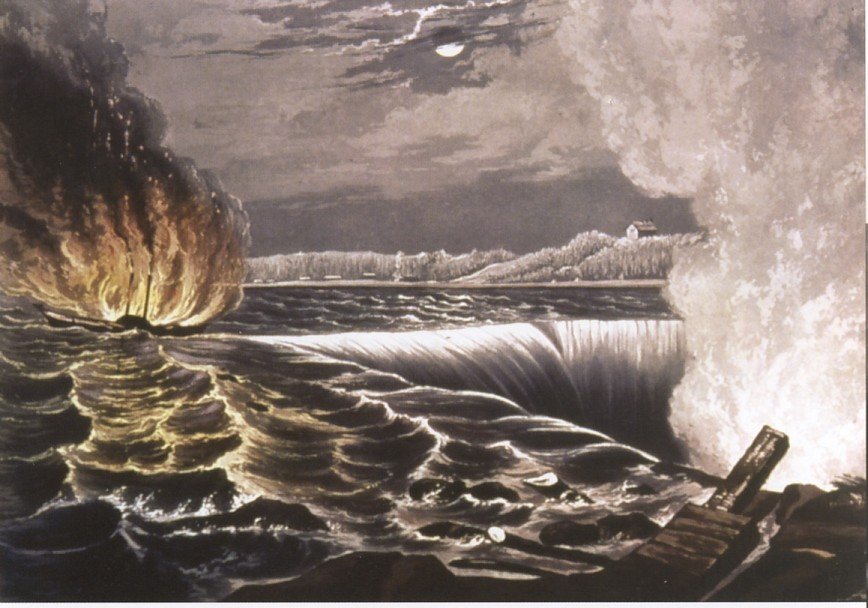
So the Canadian government is in a bit of a tough position on this, obviously, they’re aware that the Confederates are using Canada to do this, the Confederates are trying to suggest that they’re just residing there, and that all of their illicit activity is being conducted on the American side, they’re just residing in Canada, and the Canadians are kind of like, “Okay, this is gonna get really dicey. We’ve been down this road before, we don’t really want to do it again.” So there’s moments in which they threaten to extradite some of the Confederates, take them out of the country. But by and large, the timeframe that we’re talking about of these kinds of Confederate activities, is really only a period of about a year or a little bit more, which I know sounds like a long time. But when we talk about things at the federal level that, oh, that’s really not a long time, I think had this been something that was going from the earliest phases of the work, the Canadian reaction and response would have had to be a little bit more pronounced, but because these were kind of these isolated attacks that are happening on American soil, they’re starting to get more aware of it at around the same time that it’s winding down anyway.
So I do wonder to what extent there was a little bit of mindfulness of the fact that if these Confederates are looking a little bit suspicious, they may be part of something that’s a little bit bigger. I do think there was some awareness of that as well. Because again, they’re really starting to see this as a legitimate threat that they’re starting to combat. So interestingly, Beall – who is the Confederate soldier, who I guess is kind of, in some respects, the star of our show today – He’s involved in that attack on the Michigan and he’s actually in command of that particular project. He escapes after the unsuccessful capture and lives to fight another day, which just happens to be the Dunkirk to Buffalo railroad.
Devin: These weren’t exactly great criminals. Let’s talk a little bit about some of the follies of Beall and his men.
Lauren: You’re right. They weren’t very good at what they were doing. And we know this because John Beall had already been captured and imprisoned once for his actions down in the Chesapeake where he was acting as a privateer. He was caught, imprisoned, and then after he’s released, that’s when he makes his way up to Canada and starts different tactics preying on the people of New York State. But they tried several times, and were not successful at any of them. They were late, they couldn’t even get there on time, they missed the train. They put an obstacle in front/across the tracks, but the train could see it far enough in advance to be able to slow down and stop the train without any harm to the passengers or derailing the trains. So on their latest attempt, they decided, you know, this isn’t working, we’re gonna go back to Canada so they take their sleigh back to the City of Niagara Falls, and they’re waiting in the train station, when Officer David H. Thomas of Niagara, sees them sitting in the train station and thinks they look a little suspicious.
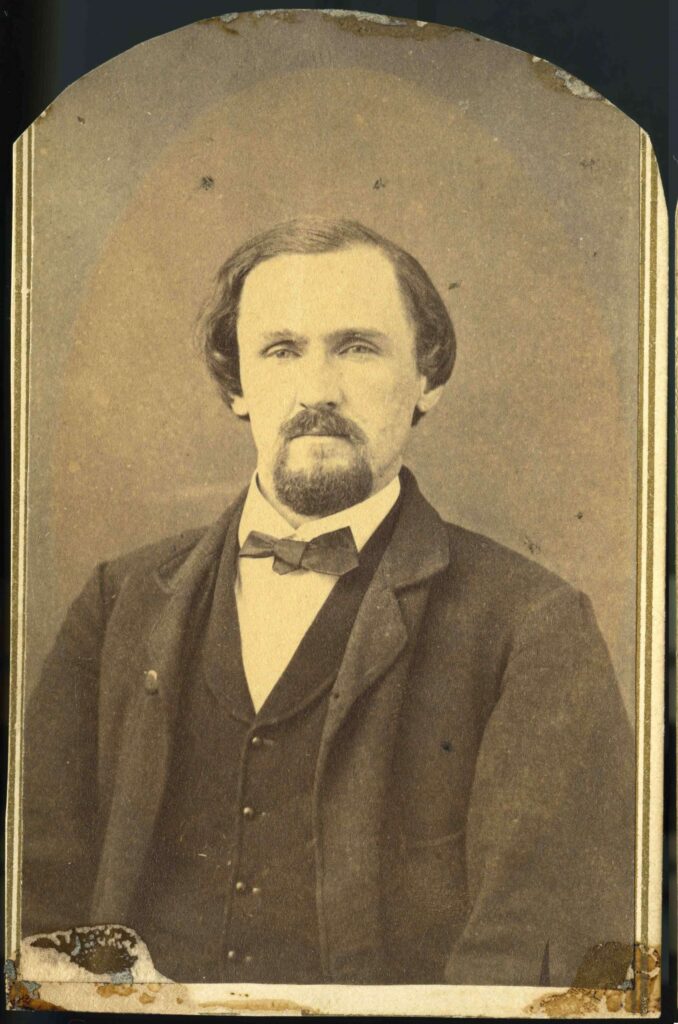
Devin: To learn more about the story, we spoke to Anton Schwarzmueller and Jim Ball from the National Railway Historical Society Niagara Frontier chapter. This was the organization that successfully applied for the Pomeroy marker.
Jim Ball: My name is Jim Ball. I’m the president of the Niagara Frontier chapter of the National Railway Historical Society. And the organization owns and operates the Railroad Museum of the Niagara Frontier.
Anton Schwarzmueller: My name is Anton Schwarzmueller, I am also a member of the Niagara Frontier chapter. I was always kind of looking out for interesting opportunities that would have some connection to railroad history, in particular local railroad history. I just happened to be reading a book by Dr. Amanda Orman called A World on Fire. And I suddenly came upon a brief note about this incident. And since the incident did happen here locally, I decided that this should be something that we need to procure a historical marker for, so that the public passing by might be informed and become interested in this. And we just went forward from there.
You know, these coaches were all made of wood, they were, you know, brittle by today’s standards, it was December, so you would have had stoves in these coaches. And if you had, indeed this did happen when you would have a coach to rail and if there was a stove in that coach, well, you know, embers go everywhere, and everything is wood and cloth. And if you’re trapped in that coach, you’re just gonna get cooked. Other things that would happen is you could have an incident where they called up telescoping, because the ends of these coaches weren’t reinforced really in any way. And if you had the coach in front suddenly stop, and you had coaches behind, you know, the weight behind the inertia going forward, you would actually have a situation where, you know, the following coach would break through, you know, the end of one coach and actually insert itself into the coach in front of it. And that was called telescoping and you probably weren’t going to survive that.
At the time, public and law enforcement and the military were aware that there were Confederate operates in Canada. And indeed, just back in October of 1864, we’re probably more aware of the St Albans Raid in St. Albans, Vermont, where a group of perhaps 22 Confederate partisans practically invaded and made their way to St. Albans, Vermont, which is not far from the Canadian border – that’s where they invaded from – and robbed several banks, and I believe one civilian was shot and killed. So certainly, local authorities were aware of the danger posed by partisans crossing the border and causing trouble. Officer Thomas would be on the lookout for confederates. But it’s sort of interesting in that when Officer Thomas entered the New York Central Depot, he assumed that Beall was an escaped prisoner, which sort of makes sense because the fellows – there were two of them, they were waiting for the 11 o’clock train to Canada. So then Beall claimed right away that yes, he was indeed an escaped prisoner from the prisoner camp in Point Lookout, Maryland, which was not the case. Officer Thomas took that to be true at the time, which is, I think, what nowadays we would call confirmation bias. And another interesting element of what Beall said was when Officer Thomas first approached him and asked him to identify himself. He gave his name as Beall. And he asked him again, some point later and Beall said, “No, no, my name is W.W. Baker.” And Officer Thomans said “No, you just told me that your name was Beall.” “No, I did not!” he replied. So even then, even with that element, he was, you know, again, misrepresented himself as an escaped prisoner.
And this is important, because he did have an Acting Master certificate from the Confederacy, which can also be a source of protection for someone who is actually taken prisoner, because then the capturing military would have to treat them as a prisoner of war. Whereas if you have a spy, which is what he was – a spy, saboteur, guerrilla – and traveling in civilian clothes; well, spies do not have the protection of say soldiers captured, like in a battlefield or, or escaped prisoners. They don’t have that protection, you might say. So that would explain why Beall stated that “yes, I am an escaped prisoner,” he probably had some idea of what happens to spies that are caught.
Devin: So when Officer Thomas arrested Beall, he was with one of his associates, a gentleman named George L. Anderson, who was a young man younger than Bealle. And when he realized that the seriousness of the charges that were going to be brought against them, which was essentially spying, and that would mean a military tribunal, and a result of which could very easily be the death penalty.
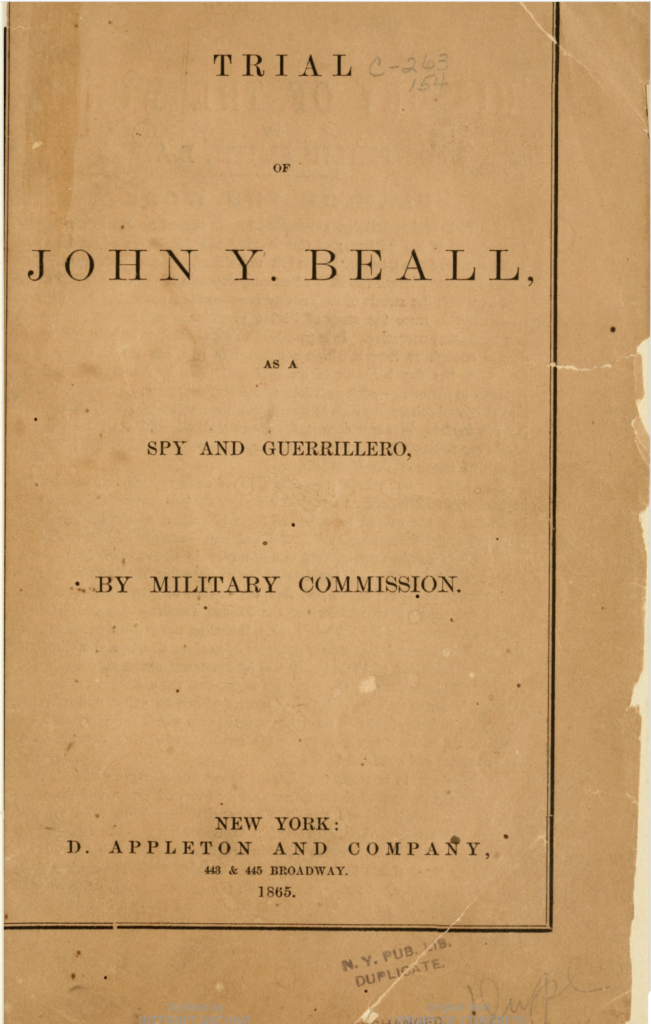
Lindsey: Anderson, being young and realizing this is really bad, breaks. He is your typical informant in the sense that he’s like, “I will take whatever plea deal I can get, this is bad, what do you need me to say?” And he completely turns on Beall. So Beall goes to trial in a military tribunal. Now we have a whole slew of new issues. He’s charged with espionage, which might not necessarily be the best indictment, because his activities aren’t really typical espionage; as such, there isn’t an intelligent side to it. But at the same time, it’s 1864. They don’t really have a concept of terrorism the way that we would, and don’t use that language. So they refer to it as guerrilla attacks. But it’s a case that his lawyer actually in that trial transcript makes in saying, “This isn’t espionage – first – which is super important, because you can’t turn it into something you didn’t do.” But second, and this is what I find so fascinating: He’s acting on orders from the Confederate government. So the fact that he’s acting on orders, the Confederate government makes it really complicated because the United States doesn’t recognize the Confederacy as a foreign government to be authorizing the orders. So he’s in a bit of a gray area, because if they say, “Okay, well the Confederate government avowed this attack,” that it’s recognizing their national authority to do so. And so he’s stuck, if you will, and ends up being found guilty and ultimately executed about two months before the war ends.
Devin: We have linked to a digital scan of the original transcript of the court case on the podcast website, which you can check out. And it’s pretty interesting because you see that Anderson not only testified against Beall, but testified against several other people who are involved who’d made it to Canada, including a person named Colonel Martin, who was kind of the brains behind the operation if there were any, but he had already fled so Beall and Anderson were the two that they captured. And Beall was the one that ended up being tried and convicted and hung.
Lauren: And the transcript makes it clear about why there was some controversy over whether Bealle deserved to die for his actions. I mean, it’s clear that he had already been convicted of this. He was not a first time offender, but he didn’t actually hurt anyone because this was unsuccessful, and he possibly, probably wasn’t the mastermind behind it. Once
Anton: Once the trial was finished, then the union government made this public knowledge so the media didn’t know that this trial was going on until they had finished and then there was some attempts in part of congressmen and some senators to ask President Lincoln to, you know, change his sentence. These attempts, these requests, these pleadings, they went unanswered.
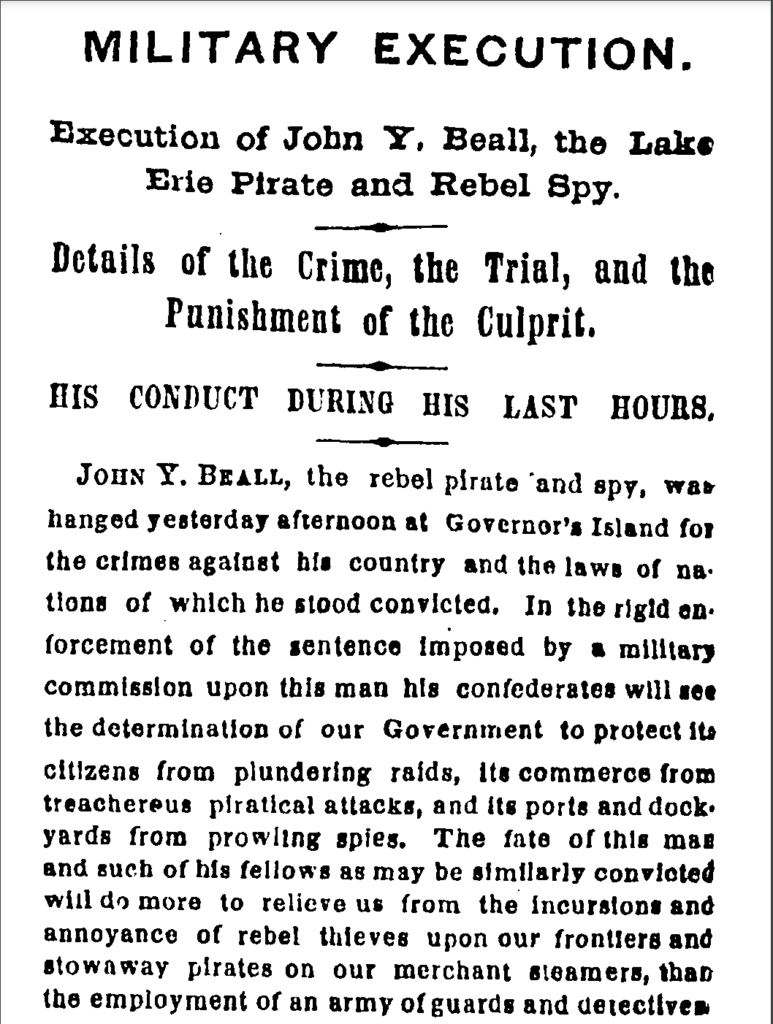
Credit: New York Times Timesmachine
Devin: So why are we talking about a marker to commemorate – in a way – an event that didn’t happen? They were not successful in derailing this train.
Lauren: I would argue that if it weren’t for this marker, this would be a story that was lost to history. And although they were unsuccessful in their several attempts, if they hadn’t been so inept, they could have inflicted real harm. And so having this marker, which, by the way, is at a modern day train station, so that we remember the importance of rail, is a way to remember that history did happen here, they were caught here, Beall was executed for his plot. And this is a way that we have a physical presence to remember that this is a different type of warfare that was going on.
Devin: Right, I agree, I think the popular image, at least that I have, when thinking about the Civil War is two big armies lining up across a field from each other and sending volleys of musket fire into each other’s ranks, and then maybe one side charges the other and, and that was the reality of a vast portion of the American Civil War. But the other part is this clandestine effort on behalf of the Confederacy to bring the war home, but to also influence Great Britain and other European nations to maybe come in on their side to help them continue the war and, you know, become victorious, which was their end goal, obviously. So, you know, these are parts of the history that we don’t always remember. And we don’t always think about when we, when we think about great events, such as The Civil War.
Jim: We are a 501 C3 nonprofit. And our mission statement is boiled down from a paragraph into three words, and that’s Preservation, Restoration and Interpretation. And the historic markers are one of the finest examples of interpretation other than our own museum that we can provide. Once they’re in place, they inform the casual visitor and the serious scholar alike and they’re permanent, they’re there for generations to come.
Lindsey: I think what I really enjoy is that they help make very clear how interwoven the past is to the fabric of our present. And when we are going through our daily lives and you encounter a marker, it gives you an opportunity to put an event in context in a place. And I think that’s so important. Because you’re absolutely right, there are all of these events that kind of exist in the ether and these markers really tie them to something physical and creates an access point for people to learn more. I think the marker for this one is just this tantalizing little tidbit that as soon as you start pulling at the threads, you realize this is a really amazing story. And it gives an opportunity for people to interact with history in that way.
Devin: Thanks for listening to A New York minute in History. This podcast is a production of WAMC Northeast Public Radio and the New York State Museum, with support from the William G Pomeroy foundation. Our producer is Elizabeth Urbanczyk.
Lauren: A big thanks to Lindsay Lauren Visser, Anton Schwarzmueller, and Jim Ball for taking part. If you enjoyed this month’s episode, make sure to subscribe on your favorite podcast platform and share on social media.
Devin: To learn more about our guests and the show, check us out at wamcpodcasts.org. We’re also on X and Instagram @NYHistoryMinute. I’m Devin Lander,
Lauren: …and I’m Lauren Roberts.
Devin: Until next time,
Both: Excelsior!
Devin: WIDE RIGHT!
